IN BRIEF: Nancy R. Hofmann [email protected]
 Plant development and responses to the environment hinge on the ability to target proteins to different areas of the plasma membrane within a cell. Indeed, the establishment of polar distributions of proteins such as PIN auxin transporters is among the key responsibilities of the endomembrane trafficking system (reviewed in Morita and Shimada, 2014). Although some features of trafficking are shared between proteins targeted to different portions of the plasma membrane, others are specific. For instance, GNOM, an ADP ribosylation factor guanine nucleotide exchange factor (ARF-GEF), appears to function in basal but not apical localization of PIN proteins (Kleine-Vehn et al., 2008). In new work, Li et al. (2017) develop and use endosidin 16 (ES16) as a pathway-specific tool to dissect the mechanisms underlying different patterns of polarity.
Plant development and responses to the environment hinge on the ability to target proteins to different areas of the plasma membrane within a cell. Indeed, the establishment of polar distributions of proteins such as PIN auxin transporters is among the key responsibilities of the endomembrane trafficking system (reviewed in Morita and Shimada, 2014). Although some features of trafficking are shared between proteins targeted to different portions of the plasma membrane, others are specific. For instance, GNOM, an ADP ribosylation factor guanine nucleotide exchange factor (ARF-GEF), appears to function in basal but not apical localization of PIN proteins (Kleine-Vehn et al., 2008). In new work, Li et al. (2017) develop and use endosidin 16 (ES16) as a pathway-specific tool to dissect the mechanisms underlying different patterns of polarity.
From a library of chemicals that disrupt endomembrane trafficking (Drakakaki et al., 2011), Li et al. identified ES16 as a compound that alters apical (shootward) localization of PIN2 in Arabidopsis thaliana root epidermis cells without affecting basal (rootward) localization of PIN1 (see Figure). ES16 treatment induced endomembrane bodies containing PIN2, indicative of disruption of trafficking, but did not alter the basal targeting of PIN1 in the root epidermis or of PIN3 or PIN7 in the stele.
While ES16 did not disrupt basal polarity, it did alter both lateral and non-polar localizations in addition to apical polarity. When the authors checked endocytosis and recycling of plasma membrane proteins, they found no effect of ES16 on uptake of FM4-64 dye (i.e., endocytosis) or on basal recycling of PIN1. By contrast, ES16 blocked recycling of PIN2 (apical polarity), PIP2a (non-polar), and NIP5;1 (lateral polarity). Thus, rather than defining a pathway specific for apical polarity, ES16 appears to target a general pathway used for non-basal targeting.
In agreement with its effects on the localization of PIN2, the phenotypes associated with ES16 treatment included inhibition of root elongation and root gravitropism. However, ES16 did not alter lateral root initiation, which depends on basal recycling of P1N1, consistent with a selective effect of ES16 on targeting pathways other than basal.
Further analysis indicated that ES16 likely disrupts a pathway that involves trafficking from the trans-Golgi network to the pre-vacuolar compartment and utilizes the RabA2A GTPase in parallel with BIG clade ARF-GEFs to modulate non-basal trafficking. In fact, a dominant negative mutation of RabA2A had similarly specific effects on PIN2 (and not PIN1) localization as ES16 treatment.
This work points to a biologically relevant distinction between basal and non-basal polarity targeting and provides an excellent tool for further dissection of post-Golgi trafficking to different areas of the plasma membrane.
REFERENCES
Drakakaki, G., Robert, S., Szatmari, A.M., Brown, M.Q., Nagawa, S., Van Damme, D., Leonard, M., Yang, Z., Girke, T., Schmid, S.L., Russinova, E., Friml, J., Raikhel, N.V., and Hicks, G.R. (2011). Clusters of bioactive compounds target dynamic endomembrane networks in vivo. Proc. Natl. Acad. Sciences USA 108: 17850-17855.
Kleine-Vehn, J., Dhonukshe, P., Sauer, M., Brewer, P.B., Wisniewska, J., Paciorek, T., Benkova, E., and Friml, J. (2008b). ARF GEF-dependent transcytosis and polar delivery of PIN auxin carriers in Arabidopsis. Current biology : CB 18: 526-531.
Morita, M.T., and Shimada, T. (2014). The plant endomembrane system–a complex network supporting plant development and physiology. Plant Cell Physiol. 55: 667-671.
Li, R., Rodriguez-Furlan, C., Wang, J., van de Ven, W., Gao, T., Raikhel, N.V., and Hicks, G.R. (2017). Different Endomembrane Trafficking Pathways Establish Apical and Basal Polarities. Plant Cell. doi: 10.1105/tpc.16.00524.
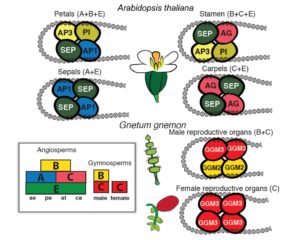 Where do flowers come from? Their sudden appearance and rapid radiation was described as an “abominable mystery” by Charles Darwin. Ruelens et al. examine the genetic toolkit that underpins reproductive organ formation in gymnosperms to uncover the origins of flowers (which they pragmatically describe as “an assembly of protective, attractive and reproductive male and female leaf-like organs”). The authors compare the four-protein complexes (floral identity quartets) that bind to and regulate genes that produce reproductive organs in angiosperms and gymnosperms. From protein phylogenies, the authors identify and reconstruct putative, ancestral forms of these DNA-binding proteins, and examine their interactions in vitro and in yeast cells. Their study finds that the angiosperm floral quartets arose by gene duplication just before the origin of flowering plants, and that the subsequent protein interaction changes were the result of gradual and reversible evolutionary change. Plant Cell 10.1105/tpc.16.00366
Where do flowers come from? Their sudden appearance and rapid radiation was described as an “abominable mystery” by Charles Darwin. Ruelens et al. examine the genetic toolkit that underpins reproductive organ formation in gymnosperms to uncover the origins of flowers (which they pragmatically describe as “an assembly of protective, attractive and reproductive male and female leaf-like organs”). The authors compare the four-protein complexes (floral identity quartets) that bind to and regulate genes that produce reproductive organs in angiosperms and gymnosperms. From protein phylogenies, the authors identify and reconstruct putative, ancestral forms of these DNA-binding proteins, and examine their interactions in vitro and in yeast cells. Their study finds that the angiosperm floral quartets arose by gene duplication just before the origin of flowering plants, and that the subsequent protein interaction changes were the result of gradual and reversible evolutionary change. Plant Cell 10.1105/tpc.16.00366 

 It’s been 20 years since the identification of BRI1, the first brassinosteroid (BR) receptor. Although many components of the BR signaling pathways have been identified, details continue to be revealed. Kang et al. examined the phenotype of a triple mutant, bri1 brl1 brl3, that lacks all three functional BR receptors. Root elongation and protophloem differentiation are both impaired in the triple mutant, and as expected fail to be rescued by exogenous BR application. The impact of adding back functional BRI1 in a cell-restricted pattern was assessed; the root meristem phenotype was not fully rescued by BRI1 expression in the epidermis or in the non-protophloem stele cells, but was rescued by expression solely in the protophloem cells. These results indicate that BR’s effects in the root involve partly cell-autonomous and partly non-cell-autonomous effects and reveal an unexpected role of the protophloem in systemically conveying BR effects in the root meristem. Development
It’s been 20 years since the identification of BRI1, the first brassinosteroid (BR) receptor. Although many components of the BR signaling pathways have been identified, details continue to be revealed. Kang et al. examined the phenotype of a triple mutant, bri1 brl1 brl3, that lacks all three functional BR receptors. Root elongation and protophloem differentiation are both impaired in the triple mutant, and as expected fail to be rescued by exogenous BR application. The impact of adding back functional BRI1 in a cell-restricted pattern was assessed; the root meristem phenotype was not fully rescued by BRI1 expression in the epidermis or in the non-protophloem stele cells, but was rescued by expression solely in the protophloem cells. These results indicate that BR’s effects in the root involve partly cell-autonomous and partly non-cell-autonomous effects and reveal an unexpected role of the protophloem in systemically conveying BR effects in the root meristem. Development 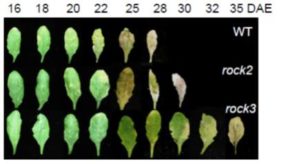 Arabidopsis has three membrane-located, histidine-kinase cytokinin (CK) receptors (AHK2, 3, and 4). Loss-of-function mutants suggest that AHK2 and AHK3 function somewhat redundantly. To further explore the roles of these receptors, Bartrina and Jensen et al. isolated dominant gain-of-function mutants, repressor of cytokinin deficiency2 (rock2) and rock3. As expected, these GoF mutants show enhanced CK signaling and sensitivity. Developmental phenotypes include an enhancement of shoot growth, delay in leaf senescence, and suppression of root growth. This study provides insights into CK receptor structure and function, as well as insights into the consequence of localized increases of CK sensitivity. Plant Physiol.
Arabidopsis has three membrane-located, histidine-kinase cytokinin (CK) receptors (AHK2, 3, and 4). Loss-of-function mutants suggest that AHK2 and AHK3 function somewhat redundantly. To further explore the roles of these receptors, Bartrina and Jensen et al. isolated dominant gain-of-function mutants, repressor of cytokinin deficiency2 (rock2) and rock3. As expected, these GoF mutants show enhanced CK signaling and sensitivity. Developmental phenotypes include an enhancement of shoot growth, delay in leaf senescence, and suppression of root growth. This study provides insights into CK receptor structure and function, as well as insights into the consequence of localized increases of CK sensitivity. Plant Physiol. 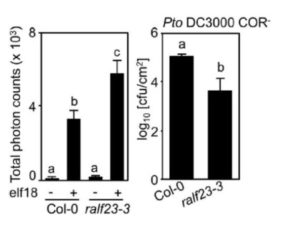 Continuing the theme of peptide signaling, Stegmann et al. showed that a subset of the RALF (RAPID ALKALINIZATION FACTOR) family of plant peptides can negatively regulate plant immune responses. When plants are treated with flg22, a peptide epitope of bacterial flagellin, they produce reactive oxygen species (ROS) as part of their defense response. The flg22 epitope is perceived by the receptor kinase FLS2. Co-application of flg22 and RALF23 or RALF33 (following their proteolytic release from the propeptide) suppresses ROS production. The receptor kinase FERONIA (FER) is necessary for RALF-mediated suppression of immunity; FER has also been shown to have a positive role in immunity by facilitating FLS2 complex formation with its co-receptor BAK1 potentially by binding to other RALF peptides that positively regulate immunity. These results show that FER fine-tunes immune receptor complex formation, via the perception of competitive endogenous peptides, which could have wide implications to understand the function of FER in multiple plant processes. Science
Continuing the theme of peptide signaling, Stegmann et al. showed that a subset of the RALF (RAPID ALKALINIZATION FACTOR) family of plant peptides can negatively regulate plant immune responses. When plants are treated with flg22, a peptide epitope of bacterial flagellin, they produce reactive oxygen species (ROS) as part of their defense response. The flg22 epitope is perceived by the receptor kinase FLS2. Co-application of flg22 and RALF23 or RALF33 (following their proteolytic release from the propeptide) suppresses ROS production. The receptor kinase FERONIA (FER) is necessary for RALF-mediated suppression of immunity; FER has also been shown to have a positive role in immunity by facilitating FLS2 complex formation with its co-receptor BAK1 potentially by binding to other RALF peptides that positively regulate immunity. These results show that FER fine-tunes immune receptor complex formation, via the perception of competitive endogenous peptides, which could have wide implications to understand the function of FER in multiple plant processes. Science 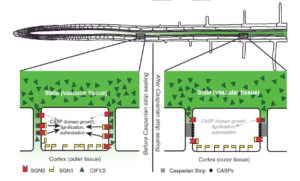 The Casparian strip is a permeability barrier that seals the spaces between root endodermis cells and so prevents bulk-flow uptake of solutes. Previously, a leucine-rich repeat receptor kinase called SCHENGEN3 or GASSHO1 (GSO1/SGN3) was identified as necessary for normal Casparian strip formation. Now, two papers in Science show that the interaction between diffusible peptides and GSO1/SGN3 regulates lignification (hence sealing) of the Casparian strip. Nakayama et al. (
The Casparian strip is a permeability barrier that seals the spaces between root endodermis cells and so prevents bulk-flow uptake of solutes. Previously, a leucine-rich repeat receptor kinase called SCHENGEN3 or GASSHO1 (GSO1/SGN3) was identified as necessary for normal Casparian strip formation. Now, two papers in Science show that the interaction between diffusible peptides and GSO1/SGN3 regulates lignification (hence sealing) of the Casparian strip. Nakayama et al. (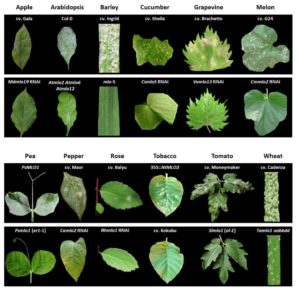 Powdery mildew disease is a broad term that encompasses more than 650 species of powdery mildew fungi that affect about 10,000 plant species, with serious economic consequences. In the 1930s/40s, broad-spectrum resistance to powdery mildew was found in barley with a loss-of-function of the Mildew resistance locus o (Mlo) gene. Subsequently, resistance conferred by induced and natural loss-of-function alleles of the Mlo gene has been demonstrated in other species. Kusch and Panstruga review research into the molecular function of MLO and the molecular basis of mlo-based resistance, as well as side-effects of mlo-based resistance and efforts to extend it to other plants. Mol. Plant Microbe Interact.
Powdery mildew disease is a broad term that encompasses more than 650 species of powdery mildew fungi that affect about 10,000 plant species, with serious economic consequences. In the 1930s/40s, broad-spectrum resistance to powdery mildew was found in barley with a loss-of-function of the Mildew resistance locus o (Mlo) gene. Subsequently, resistance conferred by induced and natural loss-of-function alleles of the Mlo gene has been demonstrated in other species. Kusch and Panstruga review research into the molecular function of MLO and the molecular basis of mlo-based resistance, as well as side-effects of mlo-based resistance and efforts to extend it to other plants. Mol. Plant Microbe Interact. 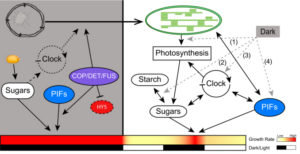 Plants use light as a source of energy and information; however, they are also sensitive and respond to light/dark diurnal cycling, with many processes happening during the dark phase of the diurnal cycle. In this review, Seluzicki et al. emphasize the importance of studying and understanding what happens with the physiology of plants in darkness. Focusing on growth and development in dark and in dark/light cycles, the authors give us a detailed account of current understanding of molecular processes underlying plant responses to darkness, including the roles of key players such as photoreceptors, transcription factors and hormones. The importance of the circadian clock and skotomorphogenesis (dark growth form) is discussed in the light of their potential multilineage evolutionary origins. The review is an exhaustive summary of many years of studies of numerous groups working on understanding how plants adjust their developmental programs in anticipation of the dark/light cycles. (Summary by
Plants use light as a source of energy and information; however, they are also sensitive and respond to light/dark diurnal cycling, with many processes happening during the dark phase of the diurnal cycle. In this review, Seluzicki et al. emphasize the importance of studying and understanding what happens with the physiology of plants in darkness. Focusing on growth and development in dark and in dark/light cycles, the authors give us a detailed account of current understanding of molecular processes underlying plant responses to darkness, including the roles of key players such as photoreceptors, transcription factors and hormones. The importance of the circadian clock and skotomorphogenesis (dark growth form) is discussed in the light of their potential multilineage evolutionary origins. The review is an exhaustive summary of many years of studies of numerous groups working on understanding how plants adjust their developmental programs in anticipation of the dark/light cycles. (Summary by 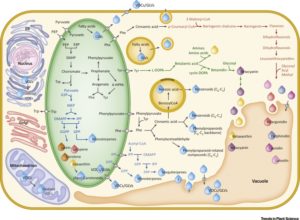 The interaction between angiosperms and their pollinators provides an excellent system to study co-evolution, and underpins the evolution of the biosynthesis of numerous interesting and useful specialized metabolites, from pigments to fragrances. Borghi et al. review the metabolic pathways that produce these signals and rewards for pollinators. Classes of compounds discussed in terms of synthesis and function include flavonoids, carotenoids, betalains, terpenoids, phenylpropanoids, green leaf volatiles and nectar. The authors also discuss trade-offs between pigments and color and odor, and how these signals and rewards affect pollination success. The integration of biochemistry and pollinator ecology makes this review particularly appealing for teaching. Trends Plant Sci.
The interaction between angiosperms and their pollinators provides an excellent system to study co-evolution, and underpins the evolution of the biosynthesis of numerous interesting and useful specialized metabolites, from pigments to fragrances. Borghi et al. review the metabolic pathways that produce these signals and rewards for pollinators. Classes of compounds discussed in terms of synthesis and function include flavonoids, carotenoids, betalains, terpenoids, phenylpropanoids, green leaf volatiles and nectar. The authors also discuss trade-offs between pigments and color and odor, and how these signals and rewards affect pollination success. The integration of biochemistry and pollinator ecology makes this review particularly appealing for teaching. Trends Plant Sci.  Plant development and responses to the environment hinge on the ability to target proteins to different areas of the plasma membrane within a cell. Indeed, the establishment of polar distributions of proteins such as PIN auxin transporters is among the key responsibilities of the endomembrane trafficking system (reviewed in
Plant development and responses to the environment hinge on the ability to target proteins to different areas of the plasma membrane within a cell. Indeed, the establishment of polar distributions of proteins such as PIN auxin transporters is among the key responsibilities of the endomembrane trafficking system (reviewed in